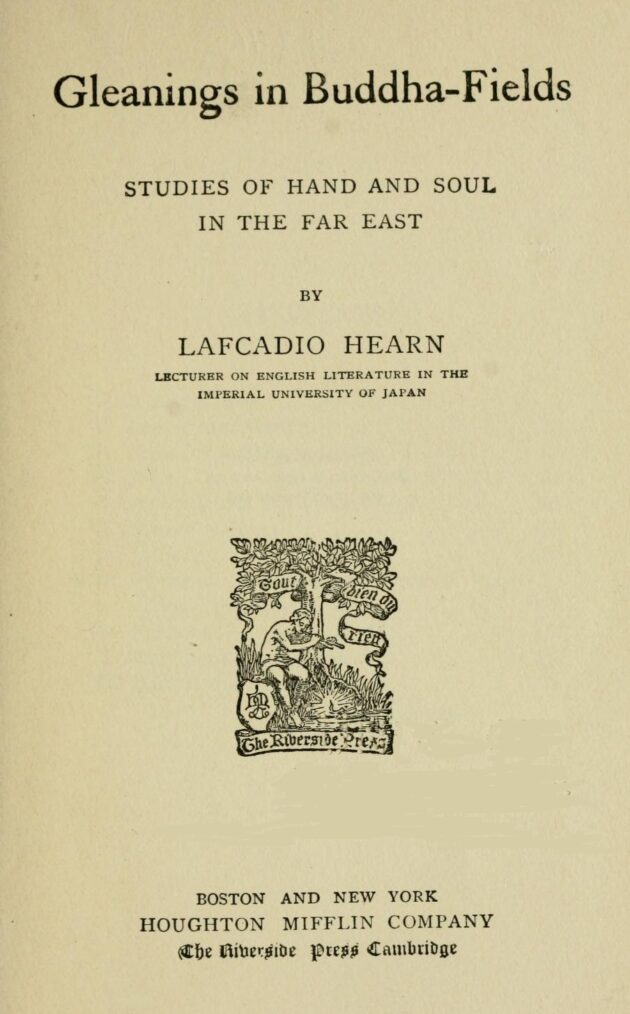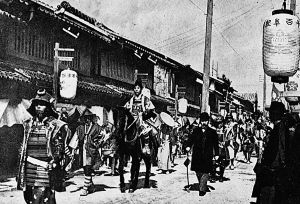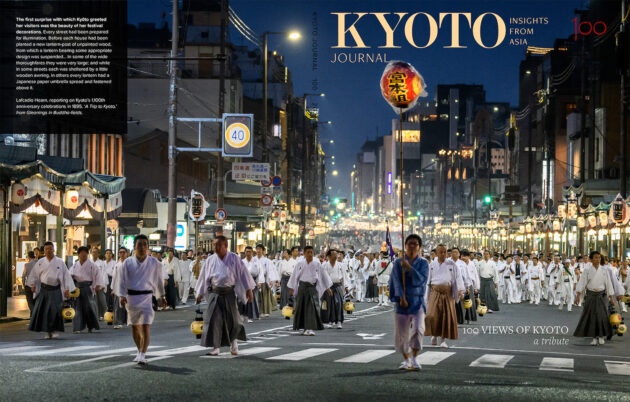
Kyoto View 90 – an excerpt from Gleanings in Buddha-fields by Lafcadio Hearn

On the back cover of KJ 100 is a short quote from the celebrated Meiji-era writer Lafcadio Hearn, describing lantern decorations he saw when visiting Kyoto (from his home in Kobe) for its 1100th anniversary celebrations in 1895. He recorded his impressions of Kyoto in a multi-part essay anthologized in his 1897 book Gleanings in Buddha-fields:
It had been intended to celebrate in spring the eleven hundredth anniversary of the foundation of Kyōto; but the outbreak of pestilence caused postponement of the festival to the autumn, and the celebration began on the 15th of the tenth month. Little festival medals of nickel, made to be pinned to the breast, like military decorations, were for sale at half a yen each. These medals entitled the wearers to special cheap fares on all the Japanese railroad and steamship lines, and to other desirable privileges, such as free entrance to wonderful palaces, gardens, and temples. On the 23d of October I found myself in possession of a medal, and journeying to Kyoto by the first morning train, which was over-crowded with people eager to witness the great historical processions announced for the 24th and 25th…
On his first day in Kyoto Hearn visits a hanging-scroll exhibition at the Omuro Palace (at Ninna-ji), delights in its garden (“the joyous storm of bird life overhead is an astonishment”), and spends an evening in enchanted sideshow alleys, perhaps reminding contemporary readers of the transformed realities of Miyazaki Hayao anime:
I passed the evening wandering through the illuminated streets, and visited some of the numberless shows. I saw a young man writing Buddhist texts and drawing horses with his feet; the extraordinary fact about the work being that the texts were written backwards,—from the bottom of the column up, just as an ordinary calligrapher would write them from the top of the column down,—and the pictures of horses were always commenced with the tail. I saw a kind of amphitheatre, with an aquarium in lieu of arena, where mermaids swam and sang Japanese songs. I saw maidens “made by glamour out of flowers” by a Japanese cultivator of Chrysanthemums. And between whiles I peeped into the toy-shops, full of novelties. What there especially struck me was the display of that astounding ingenuity by which Japanese inventors are able to reach, at a cost too small to name, precisely the same results as those exhibited in our expensive mechanical toys. A group of cocks and hens made of paper were set to pecking imaginary grain out of a basket by the pressure of a bamboo spring,—the whole thing costing half a cent. An artificial mouse ran about, doubling and scurrying, as if trying to slip under mats or into chinks: it cost only one cent, and was made with a bit of colored paper, a spool of baked clay, and a long thread; you had only to pull the thread, and the mouse began to run. Butterflies of paper, moved by an equally simple device, began to fly when thrown into the air. An artificial cuttlefish began to wriggle all its tentacles when you blew into a little rush tube fixed under its head.
When I decided to return, the lanterns were out, the shops were closing; and the streets darkened about me long before I reached the hotel. After the great glow of the illumination, the witchcrafts of the shows, the merry tumult, the sea-like sound of wooden sandals, this sudden coming of blankness and silence made me feel as if the previous experience had been unreal,—an illusion of light and color and noise made just to deceive, as in stories of goblin foxes. But the quick vanishing of all that composes a Japanese festival-night really lends a keener edge to the pleasure of remembrance: there is no slow fading out of the phantasmagoria, and its memory is thus kept free from the least tinge of melancholy.
Next day, he observed the very first Jidai Matsuri, commemorating inauguration of the brand-new Heian-jingu, in Okazaki:
When I went out, next morning, to view the great procession, the streets were packed so full of people that it seemed impossible for anybody to go anywhere. Nevertheless, all were moving, or rather circulating; there was a universal gliding and slipping, as of fish in a shoal. I find no difficulty in getting through the apparently solid press of heads and shoulders to the house of a friendly merchant, about half a mile away. How any crowd could be packed so closely, and yet move so freely, is a riddle to which Japanese character alone can furnish the key…
This vast gathering, of probably not less than a million persons, was astonishingly good-natured and good-humored, because the majority of those composing it were simple country folk. When the police finally made a lane for the procession, the multitude at once arranged itself in the least egotistical manner possible,—little children to the front, adults to the rear.
Though announced for nine o’clock, the procession did not appear till nearly eleven; and the long waiting in those densely packed streets must have been a strain even upon Buddhist patience. I was kindly given a kneeling-cushion in the front room of the merchant’s house; but although the cushion was of the softest and the courtesy shown me of the sweetest, I became weary of the immobile posture at last, and went out into the crowd, where I could vary the experience of waiting by standing first on one foot, and then on the other…

—
To describe the procession in detail would needlessly tire the reader; and I shall venture only a few general remarks. The purpose of the pageant was to represent the various official and military styles of dress worn during the great periods of the history of Kyōto, from the time of its foundation in the eighth century to the present era of Meiji, and also the chief military personages of that history. At least two thousand persons marched in the procession, figuring daimyō, kugé, hatamoto, samurai, retainers, carriers, musicians, and dancers. The dancers were impersonated by geisha; and some were attired so as to look like butterflies with big gaudy wings. All the armor and the weapons, the ancient head-dresses and robes, were veritable relics of the past, lent for the occasion by old families, by professional curio-dealers, and by private collectors. The great captains—Oda Nobunaga, Kato Kiyomasa, Iyeyasu, Hideyoshi—were represented according to tradition; a really monkey-faced man having been found to play the part of the famous Taikō.
While these visions of dead centuries were passing by, the people kept perfectly silent,—which fact, strange as the statement may seem to Western readers, indicated extreme pleasure. It is not really in accordance with national sentiment to express applause by noisy demonstration,—by shouting and clapping of hands, for example. Even the military cheer is an importation; and the tendency to boisterous demonstrativeness in Tōkyō is probably as factitious as it is modern. I remember two impressive silences in Kobé during 1895. The first was on the occasion of an imperial visit. There was a vast crowd; the foremost ranks knelt down as the Emperor passed; but there was not even a whisper. The second remarkable silence was on the return of the victorious troops from China, who marched under the triumphal arches erected to welcome them without hearing a syllable from the people. I asked why, and was answered, “We Japanese think we can better express our feelings by silence.” I may here observe, also, that the sinister silence of the Japanese armies before some of the late engagements terrified the clamorous Chinese much more than the first opening of the batteries. Despite exceptions, it may be stated as a general truth that the deeper the emotion, whether of pleasure or of pain, and the more solemn or heroic the occasion, in Japan, the more naturally silent those who feel or act.
The distinctively hushed solemnity that Hearn describes is also clearly conveyed in Patrick Hochner’s magnificent cover image of Gion Matsuri’s arai mikoshi ritual, wrapped around KJ100.

The entire text of Gleanings from Buddha-fields, including this essay’s illuminating historical evocation of Meiji Kyoto, can be accessed for free on Project Gutenburg, here.

Lafcadio Hearn (1850–1904) came to Japan in 1890 as a reporter for Harpers magazine. He soon found a position teaching, and immersed himself in Japanese culture, authoring a number of books that revealed to Western readers previously unknown aspects of local folklore, including Kwaidan, Japanese Fairy Tales and In Ghostly Japan. They were also translated into Japanese, achieving lasting popularity for recording a previously undervalued oral tradition that may otherwise have been lost.